People Management and Reward System: Challenges and Solutions Report
VerifiedAdded on 2022/09/18
|8
|2047
|27
Report
AI Summary
This report delves into the intricate relationship between people management and reward systems within organizations. It emphasizes the importance of proper remuneration and benefits in fostering a well-organized and motivated workforce. The report highlights the significance of recognizing employee efforts through various reward schemes, including salary, benefits, and appraisals, to create a fair and equitable working environment. It explores critical issues in human resource management, such as legal considerations in payment structures to avoid disparities and demotivation, the potential for incentives to diminish intrinsic motivation and creativity, and the impact of short-term incentives on long-term career goals. The report analyzes these issues through theoretical frameworks like the Human Resource value chain, the Harvard Model, and Maslow's Hierarchy of Needs, offering insights into how organizations can effectively structure reward systems to enhance employee performance, motivation, and overall organizational success. It concludes that well-structured reward systems are crucial for cost-effectiveness, workplace management, and achieving organizational goals while ensuring employee satisfaction and growth.
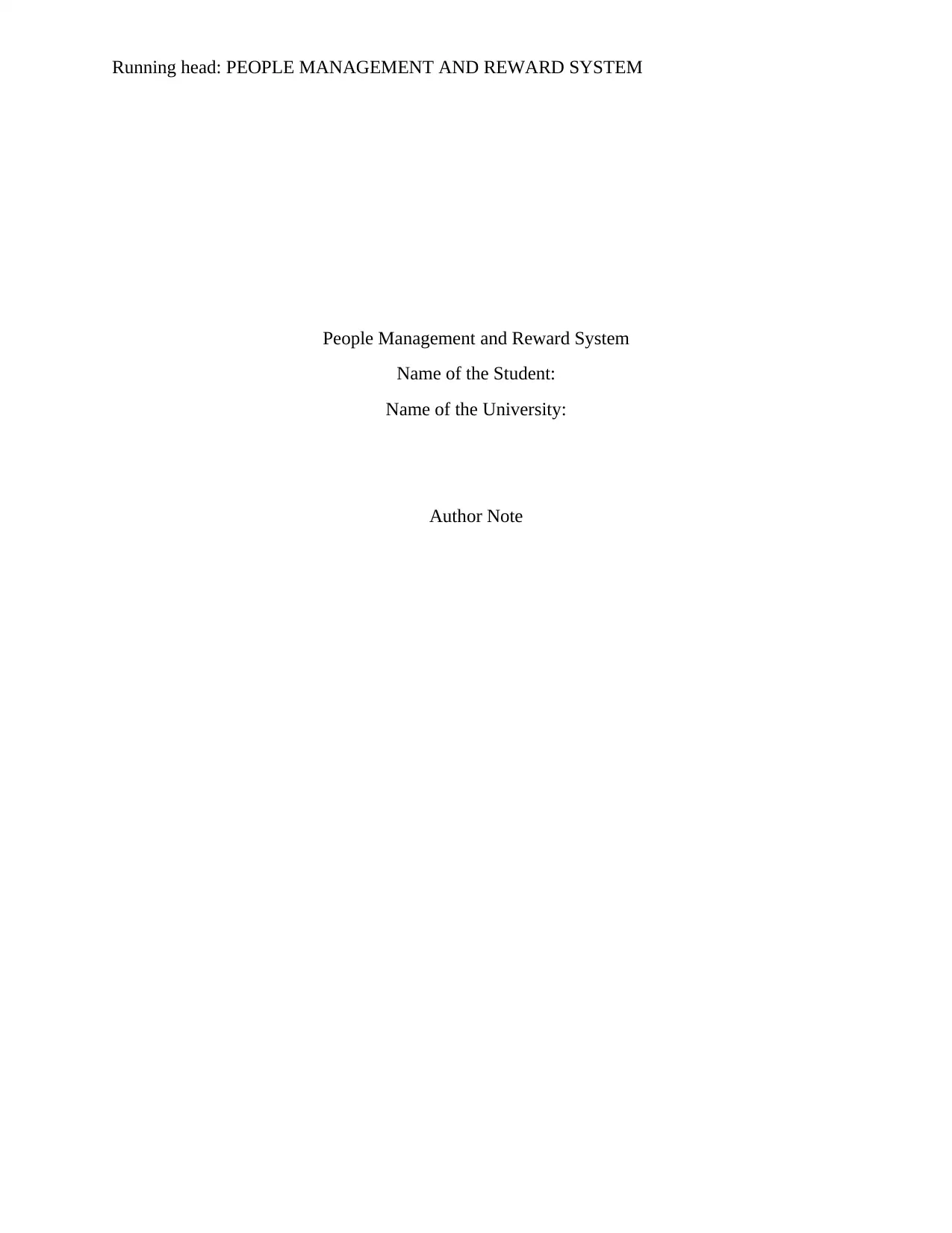
Running head: PEOPLE MANAGEMENT AND REWARD SYSTEM
People Management and Reward System
Name of the Student:
Name of the University:
Author Note
People Management and Reward System
Name of the Student:
Name of the University:
Author Note
Paraphrase This Document
Need a fresh take? Get an instant paraphrase of this document with our AI Paraphraser
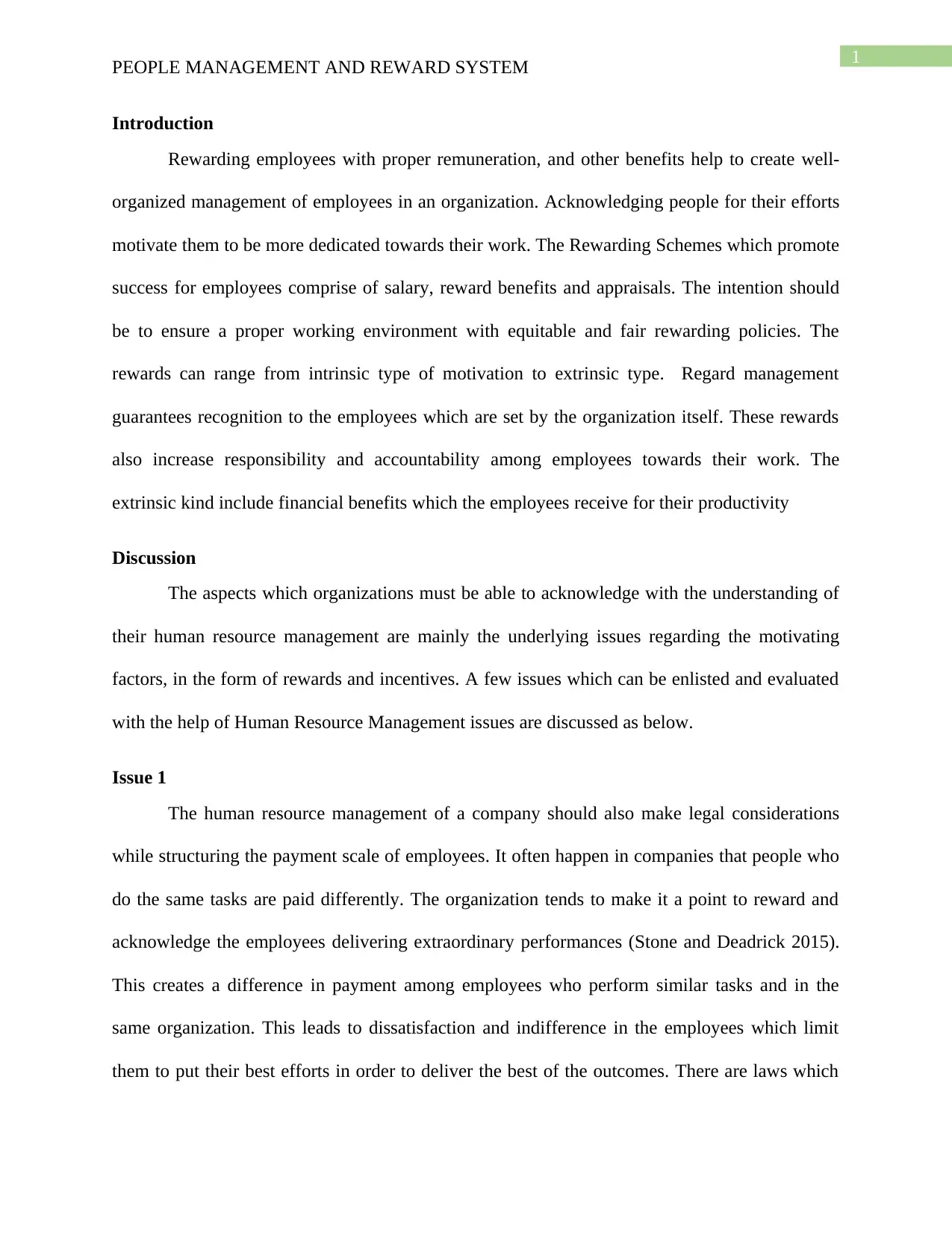
1
PEOPLE MANAGEMENT AND REWARD SYSTEM
Introduction
Rewarding employees with proper remuneration, and other benefits help to create well-
organized management of employees in an organization. Acknowledging people for their efforts
motivate them to be more dedicated towards their work. The Rewarding Schemes which promote
success for employees comprise of salary, reward benefits and appraisals. The intention should
be to ensure a proper working environment with equitable and fair rewarding policies. The
rewards can range from intrinsic type of motivation to extrinsic type. Regard management
guarantees recognition to the employees which are set by the organization itself. These rewards
also increase responsibility and accountability among employees towards their work. The
extrinsic kind include financial benefits which the employees receive for their productivity
Discussion
The aspects which organizations must be able to acknowledge with the understanding of
their human resource management are mainly the underlying issues regarding the motivating
factors, in the form of rewards and incentives. A few issues which can be enlisted and evaluated
with the help of Human Resource Management issues are discussed as below.
Issue 1
The human resource management of a company should also make legal considerations
while structuring the payment scale of employees. It often happen in companies that people who
do the same tasks are paid differently. The organization tends to make it a point to reward and
acknowledge the employees delivering extraordinary performances (Stone and Deadrick 2015).
This creates a difference in payment among employees who perform similar tasks and in the
same organization. This leads to dissatisfaction and indifference in the employees which limit
them to put their best efforts in order to deliver the best of the outcomes. There are laws which
PEOPLE MANAGEMENT AND REWARD SYSTEM
Introduction
Rewarding employees with proper remuneration, and other benefits help to create well-
organized management of employees in an organization. Acknowledging people for their efforts
motivate them to be more dedicated towards their work. The Rewarding Schemes which promote
success for employees comprise of salary, reward benefits and appraisals. The intention should
be to ensure a proper working environment with equitable and fair rewarding policies. The
rewards can range from intrinsic type of motivation to extrinsic type. Regard management
guarantees recognition to the employees which are set by the organization itself. These rewards
also increase responsibility and accountability among employees towards their work. The
extrinsic kind include financial benefits which the employees receive for their productivity
Discussion
The aspects which organizations must be able to acknowledge with the understanding of
their human resource management are mainly the underlying issues regarding the motivating
factors, in the form of rewards and incentives. A few issues which can be enlisted and evaluated
with the help of Human Resource Management issues are discussed as below.
Issue 1
The human resource management of a company should also make legal considerations
while structuring the payment scale of employees. It often happen in companies that people who
do the same tasks are paid differently. The organization tends to make it a point to reward and
acknowledge the employees delivering extraordinary performances (Stone and Deadrick 2015).
This creates a difference in payment among employees who perform similar tasks and in the
same organization. This leads to dissatisfaction and indifference in the employees which limit
them to put their best efforts in order to deliver the best of the outcomes. There are laws which
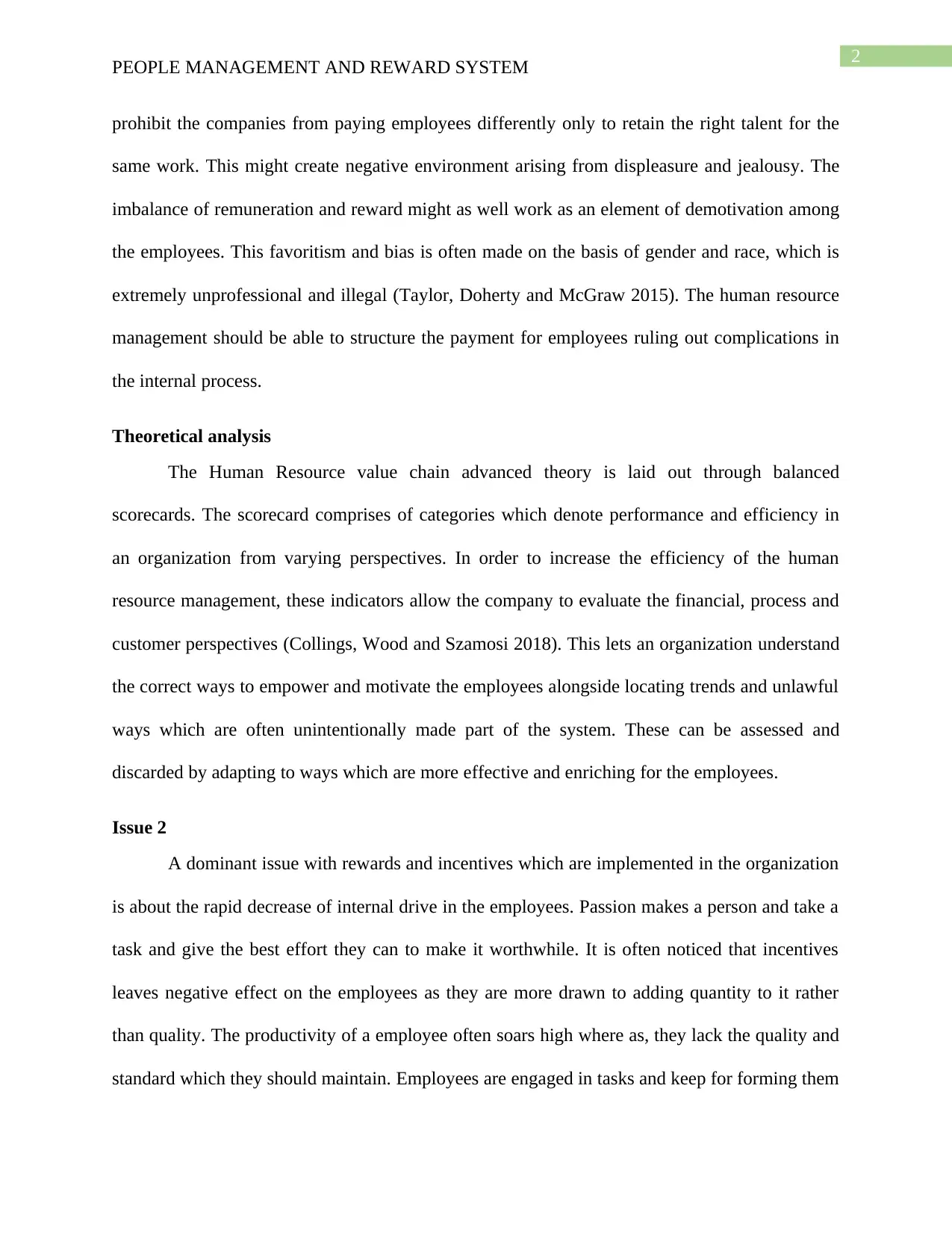
2
PEOPLE MANAGEMENT AND REWARD SYSTEM
prohibit the companies from paying employees differently only to retain the right talent for the
same work. This might create negative environment arising from displeasure and jealousy. The
imbalance of remuneration and reward might as well work as an element of demotivation among
the employees. This favoritism and bias is often made on the basis of gender and race, which is
extremely unprofessional and illegal (Taylor, Doherty and McGraw 2015). The human resource
management should be able to structure the payment for employees ruling out complications in
the internal process.
Theoretical analysis
The Human Resource value chain advanced theory is laid out through balanced
scorecards. The scorecard comprises of categories which denote performance and efficiency in
an organization from varying perspectives. In order to increase the efficiency of the human
resource management, these indicators allow the company to evaluate the financial, process and
customer perspectives (Collings, Wood and Szamosi 2018). This lets an organization understand
the correct ways to empower and motivate the employees alongside locating trends and unlawful
ways which are often unintentionally made part of the system. These can be assessed and
discarded by adapting to ways which are more effective and enriching for the employees.
Issue 2
A dominant issue with rewards and incentives which are implemented in the organization
is about the rapid decrease of internal drive in the employees. Passion makes a person and take a
task and give the best effort they can to make it worthwhile. It is often noticed that incentives
leaves negative effect on the employees as they are more drawn to adding quantity to it rather
than quality. The productivity of a employee often soars high where as, they lack the quality and
standard which they should maintain. Employees are engaged in tasks and keep for forming them
PEOPLE MANAGEMENT AND REWARD SYSTEM
prohibit the companies from paying employees differently only to retain the right talent for the
same work. This might create negative environment arising from displeasure and jealousy. The
imbalance of remuneration and reward might as well work as an element of demotivation among
the employees. This favoritism and bias is often made on the basis of gender and race, which is
extremely unprofessional and illegal (Taylor, Doherty and McGraw 2015). The human resource
management should be able to structure the payment for employees ruling out complications in
the internal process.
Theoretical analysis
The Human Resource value chain advanced theory is laid out through balanced
scorecards. The scorecard comprises of categories which denote performance and efficiency in
an organization from varying perspectives. In order to increase the efficiency of the human
resource management, these indicators allow the company to evaluate the financial, process and
customer perspectives (Collings, Wood and Szamosi 2018). This lets an organization understand
the correct ways to empower and motivate the employees alongside locating trends and unlawful
ways which are often unintentionally made part of the system. These can be assessed and
discarded by adapting to ways which are more effective and enriching for the employees.
Issue 2
A dominant issue with rewards and incentives which are implemented in the organization
is about the rapid decrease of internal drive in the employees. Passion makes a person and take a
task and give the best effort they can to make it worthwhile. It is often noticed that incentives
leaves negative effect on the employees as they are more drawn to adding quantity to it rather
than quality. The productivity of a employee often soars high where as, they lack the quality and
standard which they should maintain. Employees are engaged in tasks and keep for forming them
⊘ This is a preview!⊘
Do you want full access?
Subscribe today to unlock all pages.

Trusted by 1+ million students worldwide
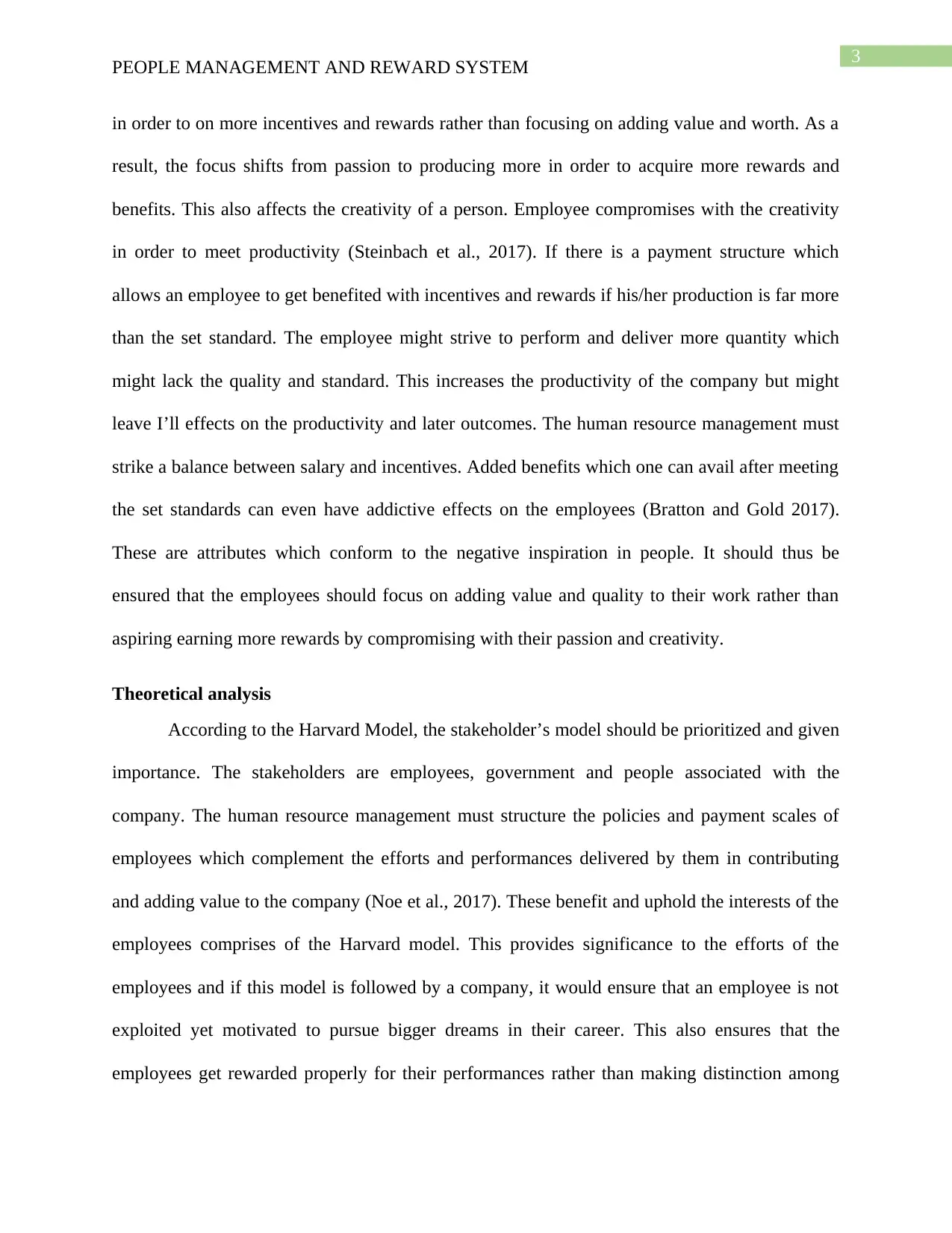
3
PEOPLE MANAGEMENT AND REWARD SYSTEM
in order to on more incentives and rewards rather than focusing on adding value and worth. As a
result, the focus shifts from passion to producing more in order to acquire more rewards and
benefits. This also affects the creativity of a person. Employee compromises with the creativity
in order to meet productivity (Steinbach et al., 2017). If there is a payment structure which
allows an employee to get benefited with incentives and rewards if his/her production is far more
than the set standard. The employee might strive to perform and deliver more quantity which
might lack the quality and standard. This increases the productivity of the company but might
leave I’ll effects on the productivity and later outcomes. The human resource management must
strike a balance between salary and incentives. Added benefits which one can avail after meeting
the set standards can even have addictive effects on the employees (Bratton and Gold 2017).
These are attributes which conform to the negative inspiration in people. It should thus be
ensured that the employees should focus on adding value and quality to their work rather than
aspiring earning more rewards by compromising with their passion and creativity.
Theoretical analysis
According to the Harvard Model, the stakeholder’s model should be prioritized and given
importance. The stakeholders are employees, government and people associated with the
company. The human resource management must structure the policies and payment scales of
employees which complement the efforts and performances delivered by them in contributing
and adding value to the company (Noe et al., 2017). These benefit and uphold the interests of the
employees comprises of the Harvard model. This provides significance to the efforts of the
employees and if this model is followed by a company, it would ensure that an employee is not
exploited yet motivated to pursue bigger dreams in their career. This also ensures that the
employees get rewarded properly for their performances rather than making distinction among
PEOPLE MANAGEMENT AND REWARD SYSTEM
in order to on more incentives and rewards rather than focusing on adding value and worth. As a
result, the focus shifts from passion to producing more in order to acquire more rewards and
benefits. This also affects the creativity of a person. Employee compromises with the creativity
in order to meet productivity (Steinbach et al., 2017). If there is a payment structure which
allows an employee to get benefited with incentives and rewards if his/her production is far more
than the set standard. The employee might strive to perform and deliver more quantity which
might lack the quality and standard. This increases the productivity of the company but might
leave I’ll effects on the productivity and later outcomes. The human resource management must
strike a balance between salary and incentives. Added benefits which one can avail after meeting
the set standards can even have addictive effects on the employees (Bratton and Gold 2017).
These are attributes which conform to the negative inspiration in people. It should thus be
ensured that the employees should focus on adding value and quality to their work rather than
aspiring earning more rewards by compromising with their passion and creativity.
Theoretical analysis
According to the Harvard Model, the stakeholder’s model should be prioritized and given
importance. The stakeholders are employees, government and people associated with the
company. The human resource management must structure the policies and payment scales of
employees which complement the efforts and performances delivered by them in contributing
and adding value to the company (Noe et al., 2017). These benefit and uphold the interests of the
employees comprises of the Harvard model. This provides significance to the efforts of the
employees and if this model is followed by a company, it would ensure that an employee is not
exploited yet motivated to pursue bigger dreams in their career. This also ensures that the
employees get rewarded properly for their performances rather than making distinction among
Paraphrase This Document
Need a fresh take? Get an instant paraphrase of this document with our AI Paraphraser
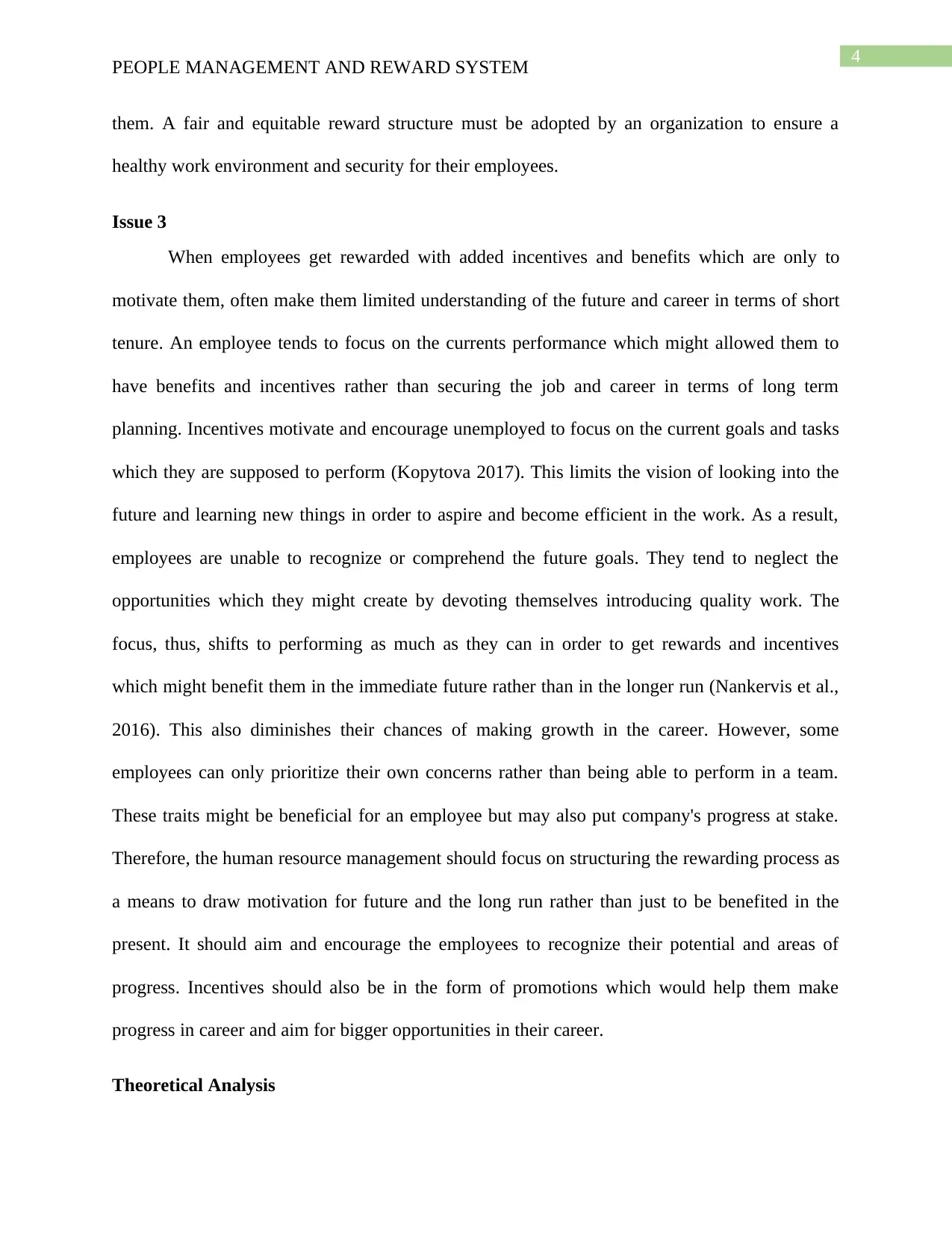
4
PEOPLE MANAGEMENT AND REWARD SYSTEM
them. A fair and equitable reward structure must be adopted by an organization to ensure a
healthy work environment and security for their employees.
Issue 3
When employees get rewarded with added incentives and benefits which are only to
motivate them, often make them limited understanding of the future and career in terms of short
tenure. An employee tends to focus on the currents performance which might allowed them to
have benefits and incentives rather than securing the job and career in terms of long term
planning. Incentives motivate and encourage unemployed to focus on the current goals and tasks
which they are supposed to perform (Kopytova 2017). This limits the vision of looking into the
future and learning new things in order to aspire and become efficient in the work. As a result,
employees are unable to recognize or comprehend the future goals. They tend to neglect the
opportunities which they might create by devoting themselves introducing quality work. The
focus, thus, shifts to performing as much as they can in order to get rewards and incentives
which might benefit them in the immediate future rather than in the longer run (Nankervis et al.,
2016). This also diminishes their chances of making growth in the career. However, some
employees can only prioritize their own concerns rather than being able to perform in a team.
These traits might be beneficial for an employee but may also put company's progress at stake.
Therefore, the human resource management should focus on structuring the rewarding process as
a means to draw motivation for future and the long run rather than just to be benefited in the
present. It should aim and encourage the employees to recognize their potential and areas of
progress. Incentives should also be in the form of promotions which would help them make
progress in career and aim for bigger opportunities in their career.
Theoretical Analysis
PEOPLE MANAGEMENT AND REWARD SYSTEM
them. A fair and equitable reward structure must be adopted by an organization to ensure a
healthy work environment and security for their employees.
Issue 3
When employees get rewarded with added incentives and benefits which are only to
motivate them, often make them limited understanding of the future and career in terms of short
tenure. An employee tends to focus on the currents performance which might allowed them to
have benefits and incentives rather than securing the job and career in terms of long term
planning. Incentives motivate and encourage unemployed to focus on the current goals and tasks
which they are supposed to perform (Kopytova 2017). This limits the vision of looking into the
future and learning new things in order to aspire and become efficient in the work. As a result,
employees are unable to recognize or comprehend the future goals. They tend to neglect the
opportunities which they might create by devoting themselves introducing quality work. The
focus, thus, shifts to performing as much as they can in order to get rewards and incentives
which might benefit them in the immediate future rather than in the longer run (Nankervis et al.,
2016). This also diminishes their chances of making growth in the career. However, some
employees can only prioritize their own concerns rather than being able to perform in a team.
These traits might be beneficial for an employee but may also put company's progress at stake.
Therefore, the human resource management should focus on structuring the rewarding process as
a means to draw motivation for future and the long run rather than just to be benefited in the
present. It should aim and encourage the employees to recognize their potential and areas of
progress. Incentives should also be in the form of promotions which would help them make
progress in career and aim for bigger opportunities in their career.
Theoretical Analysis
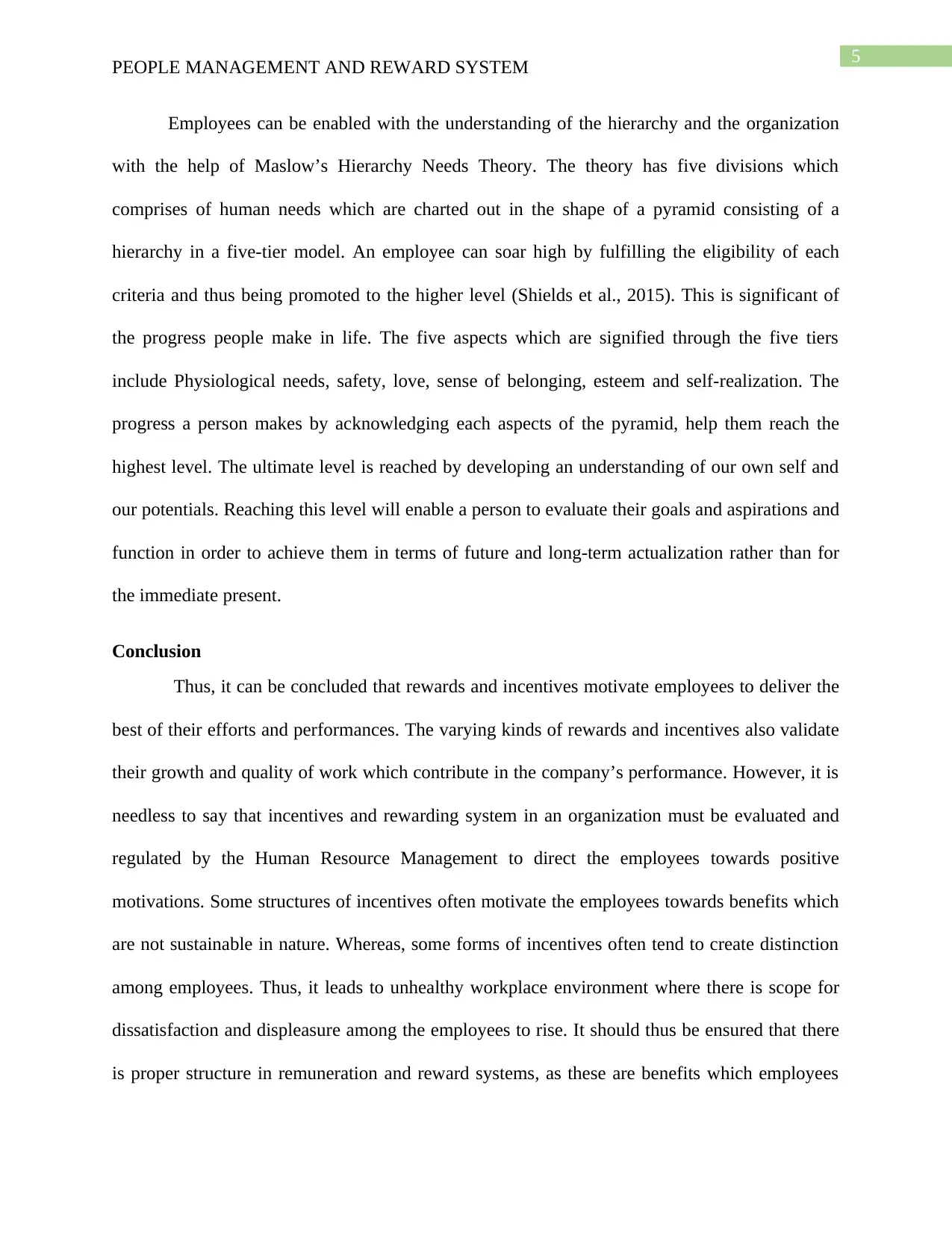
5
PEOPLE MANAGEMENT AND REWARD SYSTEM
Employees can be enabled with the understanding of the hierarchy and the organization
with the help of Maslow’s Hierarchy Needs Theory. The theory has five divisions which
comprises of human needs which are charted out in the shape of a pyramid consisting of a
hierarchy in a five-tier model. An employee can soar high by fulfilling the eligibility of each
criteria and thus being promoted to the higher level (Shields et al., 2015). This is significant of
the progress people make in life. The five aspects which are signified through the five tiers
include Physiological needs, safety, love, sense of belonging, esteem and self-realization. The
progress a person makes by acknowledging each aspects of the pyramid, help them reach the
highest level. The ultimate level is reached by developing an understanding of our own self and
our potentials. Reaching this level will enable a person to evaluate their goals and aspirations and
function in order to achieve them in terms of future and long-term actualization rather than for
the immediate present.
Conclusion
Thus, it can be concluded that rewards and incentives motivate employees to deliver the
best of their efforts and performances. The varying kinds of rewards and incentives also validate
their growth and quality of work which contribute in the company’s performance. However, it is
needless to say that incentives and rewarding system in an organization must be evaluated and
regulated by the Human Resource Management to direct the employees towards positive
motivations. Some structures of incentives often motivate the employees towards benefits which
are not sustainable in nature. Whereas, some forms of incentives often tend to create distinction
among employees. Thus, it leads to unhealthy workplace environment where there is scope for
dissatisfaction and displeasure among the employees to rise. It should thus be ensured that there
is proper structure in remuneration and reward systems, as these are benefits which employees
PEOPLE MANAGEMENT AND REWARD SYSTEM
Employees can be enabled with the understanding of the hierarchy and the organization
with the help of Maslow’s Hierarchy Needs Theory. The theory has five divisions which
comprises of human needs which are charted out in the shape of a pyramid consisting of a
hierarchy in a five-tier model. An employee can soar high by fulfilling the eligibility of each
criteria and thus being promoted to the higher level (Shields et al., 2015). This is significant of
the progress people make in life. The five aspects which are signified through the five tiers
include Physiological needs, safety, love, sense of belonging, esteem and self-realization. The
progress a person makes by acknowledging each aspects of the pyramid, help them reach the
highest level. The ultimate level is reached by developing an understanding of our own self and
our potentials. Reaching this level will enable a person to evaluate their goals and aspirations and
function in order to achieve them in terms of future and long-term actualization rather than for
the immediate present.
Conclusion
Thus, it can be concluded that rewards and incentives motivate employees to deliver the
best of their efforts and performances. The varying kinds of rewards and incentives also validate
their growth and quality of work which contribute in the company’s performance. However, it is
needless to say that incentives and rewarding system in an organization must be evaluated and
regulated by the Human Resource Management to direct the employees towards positive
motivations. Some structures of incentives often motivate the employees towards benefits which
are not sustainable in nature. Whereas, some forms of incentives often tend to create distinction
among employees. Thus, it leads to unhealthy workplace environment where there is scope for
dissatisfaction and displeasure among the employees to rise. It should thus be ensured that there
is proper structure in remuneration and reward systems, as these are benefits which employees
⊘ This is a preview!⊘
Do you want full access?
Subscribe today to unlock all pages.

Trusted by 1+ million students worldwide

6
PEOPLE MANAGEMENT AND REWARD SYSTEM
have *right over. Maintaining a proper reward system will also enable a company to be cost
effective, manage work-place and drive towards bigger success.
PEOPLE MANAGEMENT AND REWARD SYSTEM
have *right over. Maintaining a proper reward system will also enable a company to be cost
effective, manage work-place and drive towards bigger success.
Paraphrase This Document
Need a fresh take? Get an instant paraphrase of this document with our AI Paraphraser
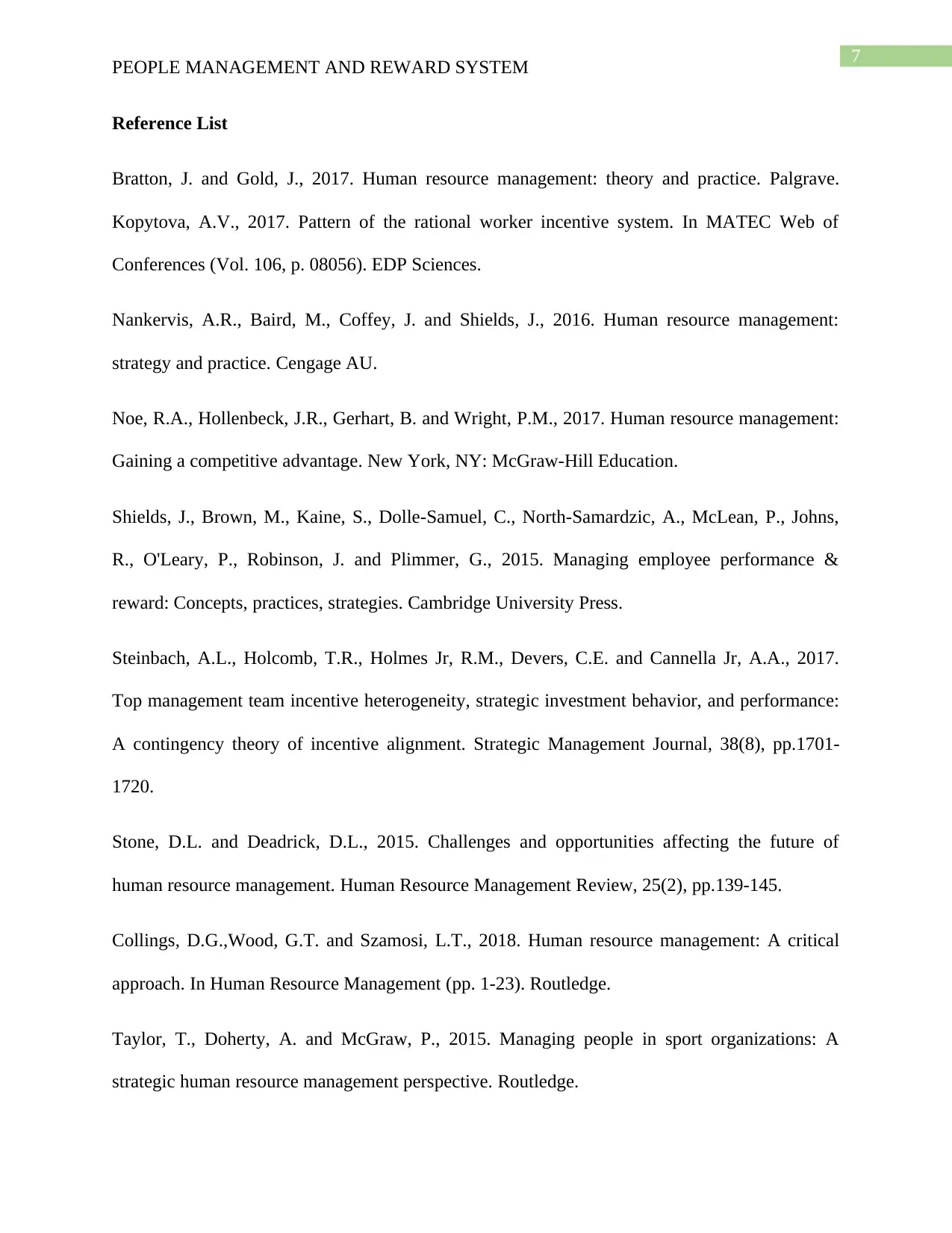
7
PEOPLE MANAGEMENT AND REWARD SYSTEM
Reference List
Bratton, J. and Gold, J., 2017. Human resource management: theory and practice. Palgrave.
Kopytova, A.V., 2017. Pattern of the rational worker incentive system. In MATEC Web of
Conferences (Vol. 106, p. 08056). EDP Sciences.
Nankervis, A.R., Baird, M., Coffey, J. and Shields, J., 2016. Human resource management:
strategy and practice. Cengage AU.
Noe, R.A., Hollenbeck, J.R., Gerhart, B. and Wright, P.M., 2017. Human resource management:
Gaining a competitive advantage. New York, NY: McGraw-Hill Education.
Shields, J., Brown, M., Kaine, S., Dolle-Samuel, C., North-Samardzic, A., McLean, P., Johns,
R., O'Leary, P., Robinson, J. and Plimmer, G., 2015. Managing employee performance &
reward: Concepts, practices, strategies. Cambridge University Press.
Steinbach, A.L., Holcomb, T.R., Holmes Jr, R.M., Devers, C.E. and Cannella Jr, A.A., 2017.
Top management team incentive heterogeneity, strategic investment behavior, and performance:
A contingency theory of incentive alignment. Strategic Management Journal, 38(8), pp.1701-
1720.
Stone, D.L. and Deadrick, D.L., 2015. Challenges and opportunities affecting the future of
human resource management. Human Resource Management Review, 25(2), pp.139-145.
Collings, D.G.,Wood, G.T. and Szamosi, L.T., 2018. Human resource management: A critical
approach. In Human Resource Management (pp. 1-23). Routledge.
Taylor, T., Doherty, A. and McGraw, P., 2015. Managing people in sport organizations: A
strategic human resource management perspective. Routledge.
PEOPLE MANAGEMENT AND REWARD SYSTEM
Reference List
Bratton, J. and Gold, J., 2017. Human resource management: theory and practice. Palgrave.
Kopytova, A.V., 2017. Pattern of the rational worker incentive system. In MATEC Web of
Conferences (Vol. 106, p. 08056). EDP Sciences.
Nankervis, A.R., Baird, M., Coffey, J. and Shields, J., 2016. Human resource management:
strategy and practice. Cengage AU.
Noe, R.A., Hollenbeck, J.R., Gerhart, B. and Wright, P.M., 2017. Human resource management:
Gaining a competitive advantage. New York, NY: McGraw-Hill Education.
Shields, J., Brown, M., Kaine, S., Dolle-Samuel, C., North-Samardzic, A., McLean, P., Johns,
R., O'Leary, P., Robinson, J. and Plimmer, G., 2015. Managing employee performance &
reward: Concepts, practices, strategies. Cambridge University Press.
Steinbach, A.L., Holcomb, T.R., Holmes Jr, R.M., Devers, C.E. and Cannella Jr, A.A., 2017.
Top management team incentive heterogeneity, strategic investment behavior, and performance:
A contingency theory of incentive alignment. Strategic Management Journal, 38(8), pp.1701-
1720.
Stone, D.L. and Deadrick, D.L., 2015. Challenges and opportunities affecting the future of
human resource management. Human Resource Management Review, 25(2), pp.139-145.
Collings, D.G.,Wood, G.T. and Szamosi, L.T., 2018. Human resource management: A critical
approach. In Human Resource Management (pp. 1-23). Routledge.
Taylor, T., Doherty, A. and McGraw, P., 2015. Managing people in sport organizations: A
strategic human resource management perspective. Routledge.
1 out of 8
Related Documents
Your All-in-One AI-Powered Toolkit for Academic Success.
+13062052269
info@desklib.com
Available 24*7 on WhatsApp / Email
![[object Object]](/_next/static/media/star-bottom.7253800d.svg)
Unlock your academic potential
Copyright © 2020–2025 A2Z Services. All Rights Reserved. Developed and managed by ZUCOL.





